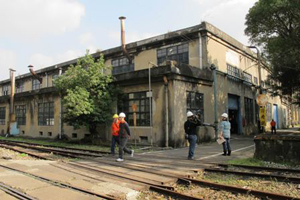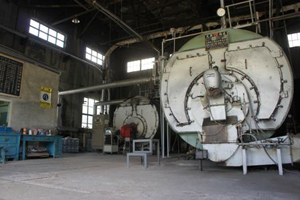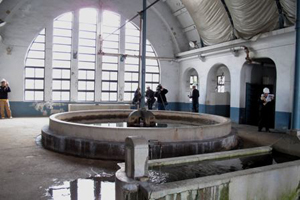Taipei Railway Workshop transformed into city historical site
By Gloria Cho Located along Civic Boulevard Sec. 5, just opposite the Living Mall, the TRW was constructed in 1933 during the Japanese colonial period. It was originally located near the city's Northern Gate but the need for larger space led to its removal to its current site. TRW occupies an area of approximately 16.8 hectares, currently accommodating ten plants, each with a specific usage. After it is relocated to Fugang in Taoyuan County this year, part of the buildings and facilities in Taipei will be designated as a city historical heritage site, including the assembly factory, metalworking factory and engine room. Taipei Mayor Hau Lung-bin said in a visit to the TRW January 14 that the site weighs heavily in the railway history of Taiwan. "It offers a great opportunity for citizens to learn more about history," he said. Echoing Hau's comments, Taipei Cultural Affairs Commissioner Liou Wei-gong noted that the festival will highlight the importance of cultural assets as well as serve as a story in the city's collective memory in terms of urban development. "A world-standard preservation plan is our target," said Liou, adding that "the Cultural Affairs Department will actively cooperate with other administrative units on an overall scheme in relation to preservation and exhibition in the future." Historical value The Taipei Government's Cultural Heritage Evaluation Committee approved the TRW as a city historical site on October 18, 2012, for several reasons. First, the building itself along with major facilities such as the assembly factory, metalworking factory, engine room, head office, and bathhouse are of representative significance in the railway industry development in Taiwan. Second, the architectural aesthetics of past eras can be seen in the high ceiling interior design, large-span steel construction, pre-cast roof, and large windows. Third, TRW shows typical factory architecture design from the Japanese occupation period and is precious because of its rarity. Among the appointed historical sites, the assembly factory stands out at 20.5 meters tall, 24 meters wide, and 16.8 meters in length, equivalent to a five-story building. It is the first stop for maintenance in which carriages are dismantled. The building features a large-span steel structure and pre-cast roof and was rather advanced for its time prior to World War II, bearing a relative significance among other industrial plants in the world. The metalworking factory, on the other hand, is responsible for forging components for machine parts produced in the depot. The factory's structure highlights reinforced concrete and trusses. Some important equipment such as a steam hammer manufactured in 1889 is preserved in a display in the building. The engine room is the depot's power supply center. "It's the heart of TRW," says Ferng. Currently two fuel boilers are in operation while a coal one has been retained for its historical value. Looming high outside the plant is an industrial chimney which forms a significant landmark for the TRW. Apart from the designated historical buildings, there are also several facilities worth preservation. One is the head office, a two-story building featuring an arch-shaped hallway. In the basement below is a space used both as an air-raid shelter and an employee dormitory in the earlier days. One point worth noting is that the shelter is accessible only from inside the office, which means it was designed for those who were on duty when an air attack occurred, says Ferng. The passenger train factory where maintenance of passenger cars takes place is another eye-catcher. Its industrial significance in terms of structure can be seen in the large windows on both sides as well as the large-span roof. After a whole day's exhausting work, employees in the TRW are treated with a hot bath every workday at four in the afternoon. "The hot water is heated with the excess steam generated and collected from throughout the operation as a way to make the most of it," notes Ferng. The foundation of the employee bathhouse can be traced back to the Japanese rule era with its shell tube shaped roof and dormer. The facility was designated a historical site in 2000. Built with a high degree of in-house design and casting, the employee's bathhouse boasts exclusive water faucets that can be rotated 360 degrees with a consistent flow. "It really helps to relieve tiredness after a whole day of work," says Huang Hsi-hsi, the Work Office Chief, who has worked at the TRW for nearly half a century. He went on to say that was true "especially for those workers who have to creep under the cars to fix things." A lifelong dedication to the railway industry One of the veteran employees in the depot, Huang embarked on his career at the early age of 15. He outshone 1900 other competitors and was among the final 40 trainees allowed into the technician cultivation projects for three years of training. During his career of over 40 years in the TRW, Huang has encountered several challenges. When he served as the chief of passenger car factory there were problems with seatbacks that failed to return to the upright position when the button was pressed, and they also had to find a way to ensure toilet doors on the railway cars could be opened from outside even if they were locked from the inside. Huang's rich experience arising from his extensive rotation among different units helped him to tackle these and other technical problems, one thing he believes newly-recruited employees lack today. "Without a substantial training period, those who enter the TRW through examination only today need a comparatively longer period of on-the-job instruction than before," says Huang. Conditions like this could get worse in the future, he warns. "Talent cultivation is therefore one of the urgent things that need to be addressed," suggests the chief. With is decades of devotion to the railway industry, Huang also notices certain circumstances that will require further discussion and improvement. He advises TRA to adopt a subcontractor system to replace the current bidding method. "Long-term cooperation with capable subcontractors will greatly aid in stable operation of the railways," opines Huang. Another field that requires equal attention is the supply of materials and components. Even today, Taiwan's railway industry relies heavily on imports in both passenger cars and related components, says Huang. "Such dependence results in fluctuations in the prices of spare materials we need for the maintenance of cars," he points out. One way to tackle the problem, in addition to getting local companies involved in making trains and related components, suggests Huang, would be to set up a research and development unit in the Fugang base. "I'm sure that such a unit would help to solve current plight and at the same time boost the railway industry in Taiwan."
Staff Writer Having shouldered the mission of fixing and maintaining railway carriages of the Taiwan Railway Administration (TRA) for nearly 70 years, the Taipei Railway Workshop (TRW) is about to be discharged from its duties as TRA's main maintenance depot and will become a historical site open to the public in the future.
Having shouldered the mission of fixing and maintaining railway carriages of the Taiwan Railway Administration (TRA) for nearly 70 years, the Taipei Railway Workshop (TRW) is about to be discharged from its duties as TRA's main maintenance depot and will become a historical site open to the public in the future.  Hau continued by saying that future plans regarding the TRW will focus on cultural heritage, and a "Railway Cultural Festival" planning is underway.
Hau continued by saying that future plans regarding the TRW will focus on cultural heritage, and a "Railway Cultural Festival" planning is underway. "It will still take two to three years to fully relocate to the new depot," notes Ferng, Jyh-ming, TRW Deputy Director. "For now, during the gradual relocation process carriages will be dismantled outside the plant and transported in via roadways."
 Wandering around the TRW, visitors will be stunned by a railway connecting the east and west end in the depot. "The rail line is used to transport and unload large machinery with the aid of an air crane," explains Ferng, adding that "it will also be reserved for display."
Wandering around the TRW, visitors will be stunned by a railway connecting the east and west end in the depot. "The rail line is used to transport and unload large machinery with the aid of an air crane," explains Ferng, adding that "it will also be reserved for display."After completing the courses, Huang was dispatched to the machine and tool plant and has undergone rotation among several units including the motor plant, engineering section and materials section. Now, Huang holds the position as the chief of the work division, in charge of allocation and management of railway car maintenance.

![Taiwan.gov.tw [ open a new window]](/images/egov.png)
